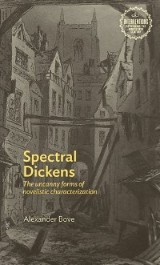Details

Spectral Dickens
The uncanny forms of novelistic characterizationInterventions: Rethinking the Nineteenth Century
|
129,99 € |
|
| Verlag: | Manchester University Press |
| Format: | EPUB |
| Veröffentl.: | 09.02.2021 |
| ISBN/EAN: | 9781526147943 |
| Sprache: | englisch |
| Anzahl Seiten: | 256 |
DRM-geschütztes eBook, Sie benötigen z.B. Adobe Digital Editions und eine Adobe ID zum Lesen.
Beschreibungen
Drawing on the recent ontological turn in critical theory, Spectral Dickens explores an aspect of literary character that is neither real nor fictional, but spectral. This work thus provides an in-depth study of the inimitable characters populating Dickens’ illustrated novels using three hauntological concepts: the Freudian uncanny, Derridean spectrality, and the Lacanian real. Thus, while the current discourse on character studies, which revolves around values like realism, depth, and lifelikeness, tends to see characters as mimetic of persons, this book invents new critical concepts to account for non-mimetic forms of characterization. These spectral forms bring to light the important influence of developments in nineteenth-century visual culture, such as the lithography and caricature of Daumier and J.J. Grandville. The spectrality of novelistic characters developed here paves the way for a new understanding of fictional characters in general.
<i>Spectral Dickens</i> posits a spectral dimension of literary character. By analyzing Dickens’ illustrated novels through a frame of ontologically haunted concepts like the Freudian
<i>uncanny</i>, Derridean
<i>spectrality,</i> and the Lacanian
<i>Real, </i>Bove’s work haunts the opposition between fictional character and real person with the uncanniness of literary forms.
<i>uncanny</i>, Derridean
<i>spectrality,</i> and the Lacanian
<i>Real, </i>Bove’s work haunts the opposition between fictional character and real person with the uncanniness of literary forms.
Introduction: An uncanny ontology of characterisation
<b>Part I<i> Spectral mimesis: portraits, caricature, and character</i></b> 1 Mimesis’s ghosts: caricature and anamorphosis 2 Spectral character: dreams, distortion, and the (cut of the) real
<b>Part II<i> “Moor eeffocish things”: effigy and the bourgeoisie</i></b> 3 Where “the specular becomes the spectral” in
<i>The Old Curiosity Shop</i> and
<i>Dombey and Son</i> 4 Imagos, dolls, and other gazing effigies in
<i>Bleak House</i>
<b>Part III<i> Beyond the realism principle: spectral materiality</i></b> 5 Dream as spectral form in
<i>Bleak House</i> and the comic surplus of Micawber in
<i>David Copperfield</i> 6 The “As if” hauntology of
<i>Little Dorrit</i> and the uncanny dream of the three fathers
<i>Bibliography</i>
<i>Index</i>
<b>Part I<i> Spectral mimesis: portraits, caricature, and character</i></b> 1 Mimesis’s ghosts: caricature and anamorphosis 2 Spectral character: dreams, distortion, and the (cut of the) real
<b>Part II<i> “Moor eeffocish things”: effigy and the bourgeoisie</i></b> 3 Where “the specular becomes the spectral” in
<i>The Old Curiosity Shop</i> and
<i>Dombey and Son</i> 4 Imagos, dolls, and other gazing effigies in
<i>Bleak House</i>
<b>Part III<i> Beyond the realism principle: spectral materiality</i></b> 5 Dream as spectral form in
<i>Bleak House</i> and the comic surplus of Micawber in
<i>David Copperfield</i> 6 The “As if” hauntology of
<i>Little Dorrit</i> and the uncanny dream of the three fathers
<i>Bibliography</i>
<i>Index</i>
Alexander Bove is Professor of English at Pacific University
<i>Spectral Dickens </i>sets out to transform some of our most basic assumptions about literary characters, especially the implicit belief that the imitation of personhood underlies characterization as a form, and typically dictates its success or failure. This volume illuminates a whole new dimension of the representation of character, a 'spectral' dimension, by bringing a wider range of modern critical theory to the study of Dickens’s illustrated novels, using in particular the three 'hauntological' concepts of the Freudian
<i>uncanny</i>, Derridean
<i>spectrality,</i> and the Lacanian
<i>real</i> to give new ontological dimensions to the basic question: "What is a fictional character?" Characters, Bove argues, are by nature uncanny in their very form. Thus,
<i>Spectral Dickens</i> exposes a deficit in our current discourse on character studies, which implicitly revolves around values like realism, depth, and lifelikeness, but has very few concepts to describe non-realist and non-mimetic forms. The book fills in this gap in the field by providing new critical concepts to account for other forms of characterization—concepts like effigy, anamorphosis, spectral materiality, and distortion, all of which take into account visual artforms, like caricature and lithography, and foreground the role of form in mediating the seemingly rigid opposition between real person and fictional character. Ultimately, the idea of spectral characterization developed here will, as a more general theory, reach far beyond Dickens’s characters to provide a richer and more nuanced understanding of fictional characters—not as imitations of reality, but as uncanny specters of the real.
<i>uncanny</i>, Derridean
<i>spectrality,</i> and the Lacanian
<i>real</i> to give new ontological dimensions to the basic question: "What is a fictional character?" Characters, Bove argues, are by nature uncanny in their very form. Thus,
<i>Spectral Dickens</i> exposes a deficit in our current discourse on character studies, which implicitly revolves around values like realism, depth, and lifelikeness, but has very few concepts to describe non-realist and non-mimetic forms. The book fills in this gap in the field by providing new critical concepts to account for other forms of characterization—concepts like effigy, anamorphosis, spectral materiality, and distortion, all of which take into account visual artforms, like caricature and lithography, and foreground the role of form in mediating the seemingly rigid opposition between real person and fictional character. Ultimately, the idea of spectral characterization developed here will, as a more general theory, reach far beyond Dickens’s characters to provide a richer and more nuanced understanding of fictional characters—not as imitations of reality, but as uncanny specters of the real.
Diese Produkte könnten Sie auch interessieren:

Politeness in Shakespeare: Applying Brown and Levinson´s politeness theory to Shakespeare's comedies

von: Abdelaziz Bouchara

43,00 €















